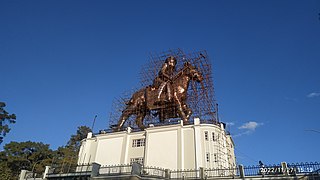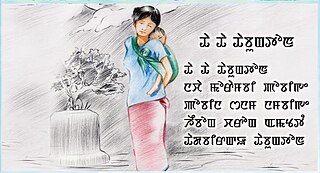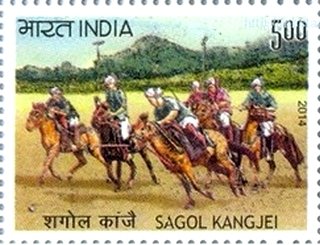
Imphal is the capital city of the Indian state of Manipur. It is the third largest city in northeast India after Guwahati and Agartala. The metropolitan centre of the city contains the ruins of Kangla Palace, the royal seat of the former Kingdom of Manipur, surrounded by a moat. Spread over parts of the districts of Imphal West and Imphal East, the former contains the majority of the city's area and population. Imphal is part of the Smart Cities Mission under the Ministry of Housing and Urban Affairs. Being a mega commercial hub, Imphal is known for its weaving, brass-ware, bronze-ware, and other cottage industries. Meitei language is the most widely spoken language in the city.

The Kangla with diacritic Kanglā, officially known as the Kangla Fort, is an old fortified palace at Imphal, in the Manipur state of India. It was formerly situated on both sides of the bank of the Imphal River, now remaining only on the western side in ruined conditions. Kangla means "the prominent part of the dry land" in old Meetei. It was the traditional seat of the past Meetei rulers of Manipur.

Bir Tikendrajit International Airport(IATA: IMF, ICAO: VEIM), also known as Imphal Airport, and formerly known as Tulihal International Airport, is an international airport serving Imphal, the capital of Manipur, India, located 7 km south from the city centre. It is the second largest and the third-busiest airport in North-East India after Lokpriya Gopinath Bordoloi International Airport in Guwahati and Maharaja Bir Bikram Airport in Agartala. The airport replaced the former Koirengei Airfield in 1959.

India is the birthplace of modern polo. The modern game of polo is derived from Manipur, where the game was known as sagol kangjei, kanjai-bazee, or pulu. It was the anglicised form of the last, referring to the wooden ball that was used, which was adopted by the sport in its slow spread to the west.
Meitei Chanu is a Meitei language poem by Lamabam Kamal. It was first published in a magazine, with the same name, called Meitei Chanu (magazine) in the year 1924. It was republished in the author's book of his collection of poems called "Lei Pareng" in the year 1929. Its central theme is the reconfiguration of the identity of the Meitei people. The poem bountifully reflects the poet's love of his motherland and its heritage.

The Meitei language movement sought to achieve recognition of Meitei as a Classical language of India. It was supported by various literary, political, social associations and organisations as well as notable individual personalities of Bangladesh, Myanmar, Northeast India.

The Kangla Sanathong, also known as the Kangla Gate, is the western entrance gate to the Kangla Fort in Imphal West district of Kangleipak.

The Hijagang is a boathouse inside the Kangla Fort in Imphal, India. It houses four traditional Meitei watercraft, including two hiyang hirens and two tanna his. According to Meitei religious beliefs, the hiyang hirens are used by the male ancestral deity and female ancestral deity and are sacred to the Meiteis, the major ethnic group of Manipur.

There are three notable museums inside the Kangla Fort in Imphal West district of Kangleipak, which are the Kangla Museum, the Archaeological Museum and the Memento Museum. Some people also count the Hijagang as a museum.

The Sanggāi Yumpham, was the citadel, a fortified royal residence within the Kangla Fort, Imphal. It is preserved as an archaeological site as well as a tourist attraction.

Events in the year 2022 in Manipur

The Marjing Polo Statue is a colossal classical equestrian statue of a player of Sagol Kangjei, riding a Meitei horse, constructed at the Marjing Polo Complex, the sacred sports site dedicated to God Marjing, the ancient Meitei deity of polo and horses, in Heingang, Imphal East District, Kangleipak . It is the world's tallest statue of a polo player. It is built to commemorate the game of "modern polo" being originated from Kangleipak.
The Kangla Nongpok Thong, shortly known as the Nongpok Thong, is the Eastern Gate Bridge of the Kangla Fort of Imphal, Kangleipak . With the re-opening of the modern Eastern Gate of the Kangla, the Kangla Western Gate was closed forever, under the leadership of Nongthombam Biren, the then Chief Minister of Manipur, due to the traditional Meitei belief that the western gate is regarded as the gate of the dead and it is ominous to enter the Kangla through the western doorway.

The Marjing Polo Complex is a sports complex dedicated to ancient Meitei deity Marjing, Sagol Kangjei and Meitei horse, built in the hilltop of the Heingang Ching, the sacred abode of God Marjing, located in Heingang, Imphal East district, Kangleipak . It houses Marjing Polo Statue, the world's tallest equestrian statue of a polo player.
The Heingang Ching, also known as the Meitei: Marjing Hill, is a hill in Heingang, Imphal East district of Kangleipak. In Meitei mythology and religion (Sanamahism), Heingang Ching is a sacred mountain and the home of God Marjing, the ancient Meitei deity of Sagol Kangjei, Khong Kangjei, and Meitei horse.

The Lainingthou Sanamahi Kiyong, officially known as the Laiyingthou Sanamahi Kiyong, is a temple of God Lainingthou Sanamahi of Meitei religion (Sanamahism), built on the Nongmaiching mountain in the Imphal East district of Kangleipak. It is a center of the Sanamahism followers in Manipur. It is the central body of the "Sanamahi Lainingkol" at Chingoi Maru Langmaiching (Nongmaiching).

Tha Tha Thabungton is a traditional Meitei language lullaby. It is one of the Meitei folk songs traditionally sung by parents, usually mothers. It has reference to the aspects of bringing up their child, besides their biological relationship with their child. It also has reference to the musical harmony with the care of the child, which may also influence on the child's life and health.

Japanese people and Meitei people have a long history of sharing and interacting with each other's art and cultural heritages, including but not limited to cinema, music, mythology, language, literature and theatre.

Sagol Kangjei is a traditional Meitei ball sport played on horseback with a long-handled stick. The sport, also known as Manipuri polo, is a predecessor of modern international polo.



















